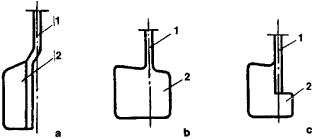rudder
rudder
[′rəd·ər]rudder

Rudder
in vessels, a device for maintaining the vessel on course and for turning the vessel while under way. The rudder is usually a slab (the blade of the rudder), which can rotate about its vertical axis (vertical rudder). When the rudder is turned from the straight position, its surfaces are subjected to hydrodynamic forces that shift the vessel from the trajectory of steady-state motion. The rudder blade is flat or streamlined.
Rudders may be of the simple, balanced, and semibalanced

type, depending on the position of the rudder blade in relation to its axis of rotation (see Figure 1). Less force is required to turn balanced rudders in comparison with simple rudders. A vessel’s maneuverability and controllability depend on the rudder’s characteristics, including area and shape. The rudder is usually located at the vessel’s stern; it may sometimes be mounted at the bow, for example, in ferryboats.
On some vessels, the rudder’s function is performed by deflection nozzles, which change the direction of the stream of water thrust back by the vessel’s propeller. Vessels with rotary-blade propellers can maneuver without the use of a rudder. In addition to vertical rudders, horizontal rudders (diving planes or diving rudders, used to control motion in a vertical plane) are installed on submarines. Rudders may also be equipped with a propeller on the blade in order to improve controllability at low speeds and for maneuvering at standstill.
E. G. LOGOVINOVICH